OM50
Standard magnetic quadrupole singlet
lens
- Novel integral construction: cut to micron precision from a
single stress- relieved
billet of high quality magnet iron.
- Hyperbolic pole profile and precise four-fold simmetry
ensures very pure quadrupole filed quality
over the 15 mm lens bore diameter.
- Negligible parasitic aberrations as measured by the grid
shadow technique.
- Nickel plated for a durable finish.
- A single lens produces a line focus.
- Parallel gap between adjacent poles for the accurate
monitoring of magnetic field.
|
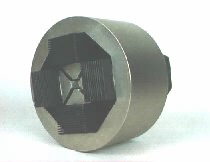 |
OM52
Miniature quadrupole singlet lens
- Uses the same high precision construction as the standard
OM50 lens
- Mechanical length is half of OM50 to allow use in short
systems
- Extended pole on one face to minimise space between lens
and sample
- Bore diameter of 7.5mm and 15 coil turns per pole give a
maximum pole tip field of around 0.9 Tesla
|
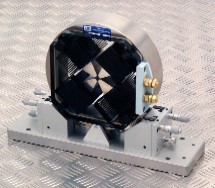
|
OM55 High
strength quadrupole singlet lens for high energy heavy ions
Externally identical to standard OM50 lens
Bore diameter of 7.5mm and 15 coil turns per pole give a maximum pole
tip field of around 0.9 Tesla
A triplet of these lenses will focus ions up to around 160 MeV.amu/q2
|
 |
OM100
Basic doublet comprising two OM50
lenses
- Mounted on a precision micrometer controlled table for easy
alignment:
5 µm vertical and horizontal, and 50 µradian rotational
alignment.
- With conventional accelerators, micron sized beam spots are
achieved
with high (100 pA) transmission.
- Using precision Hall effect probes to measure the magnetic
field generated between adjacent
poles for a particular beam focus, then this focus can be generated
easily at a larger stage by reproducing
the lens magnetic fields.
|
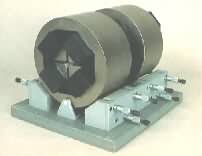 |
OM150
Enhanced focusing coupled triplet
system comprising three OM50 lenses
- Mounted on a precision micrometer controlled table for easy
alignment:
5 µm vertical and horizontal, and 50 µradian rotational
alignment.
- With large demagnification parameters in both horizontal
and vertical planes,
submicron performance with high beam transmission (100 pA) is routine.
- Using precision Hall effect probes to measure the magnetic
field generated between adjacent
poles for a particular beam focus, then this focus can be generated
easily at a larger stage by reproducing
the lens magnetic fields.
|
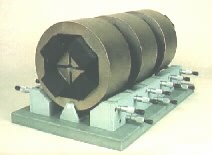 |
OM170 Monobloc triplet of OM52 lenses for
vertical mounting
- A closely spaced triplet
of miniature OM52 lenses designed for vertical mounting
- Monobloc assembly using
precision ground spacers ensures accurate translational alignment
eliminating the necessity for precise lateral adjustments
- Top lens permits
rotational adjustment for final trimming
- Compact assembly with
ducts for cooling air
|
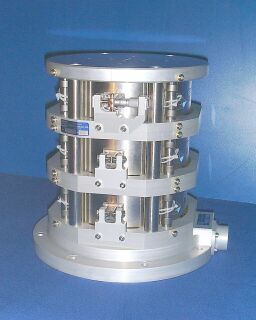
|
OM50e
Matching power supplies for the
magnetic quadrupole lenses
- 0-100 A stabilised to 1 part in 100 thousand.
- 2 required for the doublet OM100 and coupled triplet OM150
systems.
|
 |
OM10
Precision differential micrometer
controlled beam defining slits
- Stainless steel construction with edge welded sealed
bellows for reliable high vacuum operation.
- Low scatter slit jaw geometry with an adjustable precision
of 1 µm.
- Aperture range of 0-5000 µm.
- Used as both beam defining object apertures and beam
divergence limiters.
|
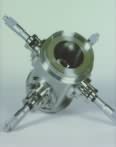 |
OM25
Ferrite cored pre-lens deflector coils
constructed as a compact box deflector
- Enables MeV ions to be rastered over the sample at
deflections of up to 2 mm,
depending on the energy, mass and charge state of the ion.
- Aperture diameter of 25 mm.
- 10 % tap is provided on each coil to improve the accuracy
of scanning at small amplitudes.
|
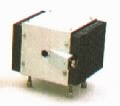 |
OM70
Stainless steel high vacuum compatible
target chamber of octagonal design
- Incorporates a top mounted edge-welded bellows sealed XYZ
target manipulator with quick
access target change system.
- Flexible geometry with 8 access ports, to incorporate a
wide variety of detectors, microscope assemlies
and viewing windows.
- Zoom microscope provided for sample and beam profile
viewing.
- Pumping through 4 inch vacuum port on underside of chamber.
|
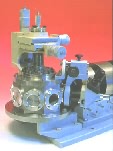 |
OM2000
Ion microbeam endstage
- Incorporates the target chamber OM70, triplet lens assembly
OM150, scan system deflection coil
OM25 and beam divergence limiter slits OM10 mounted on an integral
support table.
|
 |
OM2020
Stand-alone external beam endstage for in-air applications such as
archaeometry
- Doublet focusing external beam system
- Single pillar mounting for all endstage components:
- OM100 doublet lens
- Collimator slit
- Easy-to-change exit nozzle using thin Kapton foil
- Front viewing video microscope
- Versatile mounting system for particle detectors etc.
|
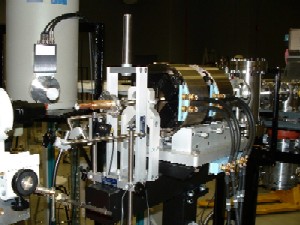
|
OM2050 External beam add-on for OM70 target
chamber
External beam system
attaches to back port of OM-70 target chamber offering a simple
low-cost
option for implementing in-air applications such as archaeology.
- Beam focusing and
scanning provided by existing lens system
- Easy-to-change exit
nozzle using thin Kapton foil
- Front viewing video
microscope
- Versatile mounting
system for particle detectors etc.
|
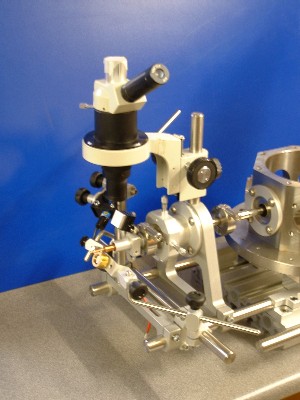
|
OM40e dual
scan amplifier
- A twin channel power amplifier designed to drive the OM25
deflection coils.
- Produces a bipolar constant current output of 0 to +5 A
from an analogue input voltage of 0-10 V.
|
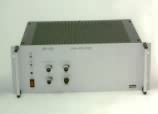 |
OM35e
Ultra-sensitive charge digitiser,
scaler and current indicator
- Sensitivity of 10 fC per pulse (100 kHz per nA).
- Features an analogue logarithmic display of the
instantaneous beam current from
0.1 pA to 1 nA (other ranges on request).
|
 |
OM-DAQ
Data acquisition system
comprising a complete hardware and software
package for the collection of PIXE, RBS, STIM elemental maps and energy
spectra from
scanning high energy ion microbeams system
- Based around a standard PC compatible computer (at least
486) and an OM-DAQ interface
unit (OM-1000e).
- When coupled with the OM scanning system, correlates data
from up to 8 X-ray or particle
detectors to generate on-line energy spectra and on-line 2D maps.
- A user-friendly Windows interface allows a mouse driven
selection of the programme functions
in a simple logical manner. The software is written in fast efficient
C, with the critical portions
coded in assembler.
- On-screen display of instantaneous beam current,
accumulated charge and dead time.
- Automatic generation of run numbers and storage of
experimental conditions
for efficient error free data handling protocols under high work-loads.
- On-screen identification of PIXE emission lines and RBS
surface energies.
- Click here to download the
software.
|
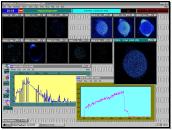 |
DAN32 is
a 32-bit Windows interface for GUPIX and
RUMP.
- Provides a user friendly graphical interface to the
standard unmodified GUPIX.
- Fits to simultaneous RBS spectra with internal exchange of
data to PIXE
spectra and 'Q factor' charge correction.
- Designed to interface smoothly with OM-DAQ, but will read
and write
spectra in a variety of configurable ASCII and binary formats.
- Output to printer or spreadsheet files.
- Click here
to download the
software.
|
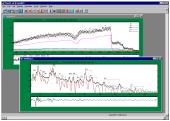 |
XYZ stepper motor stage control software
Provides a software interface between OM_DAQ and a
three-axis stepper motor controller for sample positioning
Two modes of operation:
Stand-alone
|
Fully integrated with OM_DAQ
|
Manual positioning with
mouse or keypad
|
Move to centre of current
scan
|
Move to specified position
(absolute or relative)
|
Move to location of a
previous run
|
Move to stored position
|
Mechanical scanning with
same scan modes as magnetic scanning
|
Configure speed, axis
direction, etc.
|
Store preset sequence of
sample positions and magnetic scan modes for fully automated operation
|
Currently configured to operate with the following motor
controllers:
- Parker L25/L50 series (RS232 interface, CANbus interface
under development)
- Newport MM4006 (GPIB interface)
Other controllers can be implemented on request
|

|



















